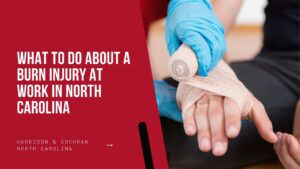
Burns are among the most devastating injuries that a worker may suffer on the job. A worker who has suffered a burn injury needs immediate medical care.
If you witness a co-worker being burned by open flame, scalding water or steam, electricity, etc., you should summon help immediately. You can also render assistance until help arrives.
A worker who has suffered a burn injury on the job may be entitled to workers’ compensation benefits, which include paid medical care and partial replacement of lost wages. A workers’ compensation attorney at Hardison & Cochran can help you seek all the benefits you deserve after a work-related injury.
Types of Workplace Burns
The types of burn injuries that occur on the job include:
- Thermal burns from contact with an open flame or another direct heat source, such as a stove, industrial machinery, hot liquids, or steam.
- Electrical burns from contact with electric currents, sparks, or arcs.
- Chemical burns from exposure to corrosive or caustic materials, including industrial cleansers and other solvents.
- Radiation burns from exposure to X-rays, sun lamps, and other radiation sources.
- Friction burns from contact with roads and other hard surfaces.
Burns to the hands and wrists are among the most commonly reported work-related burn injuries, followed by burns of the upper limbs and burns of the face, neck, and/or head.
What To Do Immediately After a Burn Injury at Work
If a co-worker suffers a burn of any kind in the workplace, you should immediately summon help, including emergency medical treatment. You should also render assistance until help arrives.
When a person’s clothing catches fire, you should help the individual “stop, drop, and roll” to put out the flames. If a blanket, jacket, or other piece of material is handy, use it to grab the worker if they need calming and to smother the flames.
The jolt from an electrical burn can knock the victim down, resulting in additional injuries from the fall. A significant electrical jolt can cause a heart rhythm disturbance or cardiac arrest. You need to determine whether the burn victim is still in contact with the source of electricity. If they are, move the source away from you and the injured person using a dry, nonconducting object made of cardboard, plastic, or wood. If you can, turn off the source of electricity
Once the electricity is off, check for signs of breathing, coughing, or movement. Begin cardiopulmonary resuscitation (CPR) if needed. To prevent shock, lay the victim down with their head slightly lower than their trunk, if possible, and their legs elevated.
After a minor chemical burn, rinse the skin with cool water for 10 to 20 minutes.
Burn victims quickly experience swelling. It is important to promptly remove necklaces, bracelets, and rings from a burn victim’s body. Remove the victim’s burned clothing. Where clothing sticks to the body, cut around it; do not tear the skin.
Burns are often described as first-degree, second-degree, or third-degree burns.
- A first-degree burn should be treated with wet compresses or immersion in cool water until the pain subsides. Cover the burn with a bandage or sterile gauze. A first-degree burn covering substantial portions of the hands, feet, face, groin, buttocks, or a major joint requires emergency medical attention.
- A second-degree burn no larger than 3 inches can be treated like a first-degree burn and then should be seen by a doctor. If the burned area is larger or the burn is on the hands, feet, face, groin, buttocks, or over a major joint, get medical help immediately.
- A third-degree burn requires immediate medical attention. Cover the burned area with a cool, moist bandage or towel. Elevate the burned area above the victim’s head if possible. If the victim shows signs of shock, have them lie flat, cover them with a blanket, and elevate their feet about 12 inches.
Report a Workplace Burn Injury to Your Employer
Someone should help a burn victim by ensuring that their supervisor and employer have been notified about workplace accidents and burn injuries as soon as possible. If the employer has specific reporting procedures, they should be followed.
The burn victim or a co-worker should take photos of the injury and the accident scene if it is safe. They should also record the names of witnesses to the accident.
North Carolina Workers’ Compensation for Burn Injuries
If workplace burn injuries cause a worker to miss seven days of work, the injured worker should be eligible to receive workers’ compensation benefits. Workers’ compensation is no-fault insurance that pays 100% of an eligible worker’s medical expenses related to a workplace injury, including vocational rehabilitation, if necessary, a portion of lost wages, and stipends for permanently disabling injuries or disfigurement.
A burn victim may receive:
- Temporary total disability benefits, which replace up to two-thirds of the employee’s pre-injury weekly income for up to 500 weeks from the date of injury. TTD benefits are typically paid until the employee returns to work or reaches maximum medical improvement and is released from care.
- Temporary partial disability benefits may be available to an employee who can return to work with modified duties or restrictions. TPD benefits replace up to two-thirds of the employee’s pre-injury weekly income for up to 500 weeks from the date of injury. They will be reduced by any amount of compensation the employee earns while performing light-duty work.
- Permanent partial disability benefits are based on the severity of the impairment and its impact on the worker’s ability to earn wages. PPD may be available to a burn victim who has suffered a permanent impairment that affects their ability to perform certain job functions. The benefit a worker receives is based on a number of factors, including their pre-injury average weekly wage, their disability rating, and the schedule of injuries, which specifies the number of weeks benefits are paid for certain injuries.
Under the schedule of injuries, for example, workers’ comp pays up to $20,000 for serious facial or head disfigurement and up to $10,000 for other serious bodily disfigurement not otherwise compensated for.
- Permanent Total Disability benefits are payable to an employee who has suffered second-degree or third-degree burns to 33% or more of their total body. PTD benefits, including compensation for medical care and wage replacement, are paid for life. If the employee is shown to be capable of returning to suitable employment, this may impact their wage replacement benefits.
It is important to understand your rights and the potential limitations of workers’ compensation. A workers’ compensation lawyer can guide you through the claims process and advocate on your behalf if your employer or their workers’ compensation administrator questions your eligibility for benefits.
Are You Thinking About a Burn Injury Lawsuit in North Carolina?
Most businesses in North Carolina are required to provide workers’ compensation insurance coverage to protect their employees in the event of an accident. In exchange, businesses are shielded from lawsuits by employees who have been injured on the job.
However, if someone other than your employer or a co-worker caused your work-related injuries, then they may be held financially accountable through a personal injury lawsuit.
A third-party claim may be possible for a burn injury suffered by an employee at a job site in such cases as:
- Subcontractors / non-employers – If subcontractors or others who work for a different company were careless at the job site and their carelessness led to the accident that injured you, they may be held financially liable through a personal injury lawsuit.
- Property hazards – A worker injured while performing their job on unsafe property owned by someone other than their employer may file an injury lawsuit against the property owner or the landlord if a property hazard contributed to their injury.
- Faulty equipment/machinery – If you sustained work-related injuries because of faulty or malfunctioning equipment or machinery, you could file a third-party claim against the manufacturer, distributor, or supplier of the unsafe equipment or machinery.
To proceed, your attorney would seek evidence of negligence or recklessness by some other person or entity besides the employer that contributed to the worker’s injury.
A third-party lawsuit would be entirely separate from a workers’ compensation claim. Both could proceed at the same time.
It is important to work with a personal injury attorney who understands North Carolina’s workers’ compensation laws.
A Workplace Injury Attorney Can Help You Seek The Results You Want
Once you have received medical care and are stabilized after a workplace burn injury, you should contact the Raleigh workers’ compensation lawyers at Hardison & Cochran. Our law firm represents injured workers with workers’ compensation claims in North Carolina. We’ll discuss the options available to you and ensure that your workers’ compensation claim is filed correctly. We will work to recover the maximum compensation available to you.
Contact the experienced North Carolina workers’ compensation lawyers at Hardison & Cochran toll-free at (800) 434-8399 or fill out our online contact form.





Leave a comment